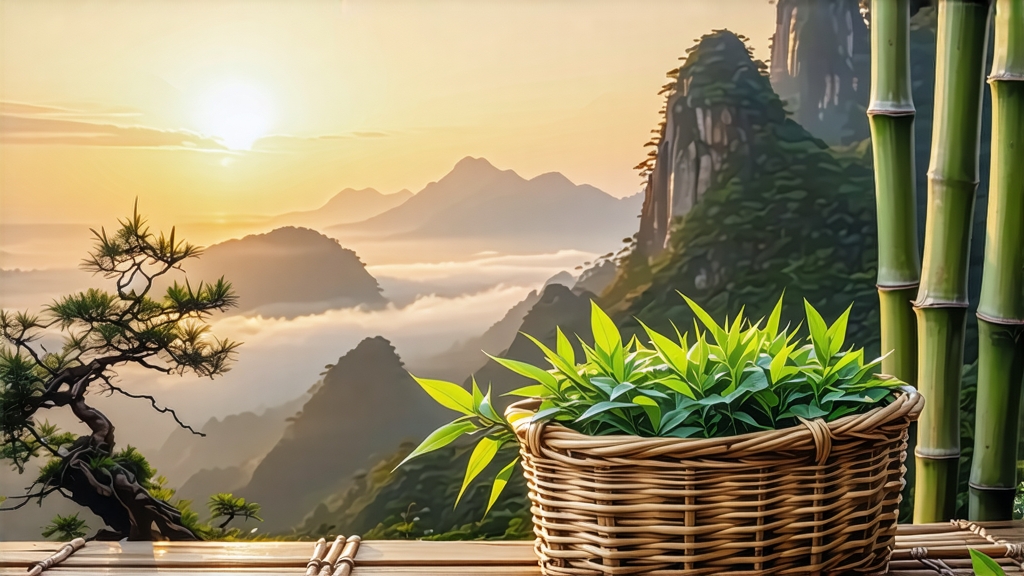
Tucked away in the cloud-veiled peaks of Sichuan’s Meng Ding Mountain, Meng Ding Huang Ya—literally “Meng Ding Yellow Bud”—is the quiet aristocrat of Chinese tea. While green teas grab headlines and pu-erhs fill auction catalogs, this yellow tea has spent thirteen centuries perfecting a single trick: capturing spring in a slow-motion embrace between green freshness and autumnal mellowness. To understand it is to witness a vanished dynasty’s palate, still breathing inside a downy bud.
-
A leaf born of legend
According to county annals compiled during the Tang dynasty, a Buddhist monk named Wu Lizhen planted seven tea bushes on Meng Ding’s summit in 53 BCE. By the Tang (618-907 CE) the buds were rolled in silk, carried by fast horses to Chang’an, and served to emperors who believed the mountain’s perennial mist distilled immortality. Song dynasty poet Lu You praised its “golden liquor born of clouds,” and Ming dynasty statutes fixed the annual tribute at 360 cakes, each pressed with the imperial dragon seal. When the Qing switched their loyalty to fragrant green teas, Meng Ding Huang Ya retreated into monastic obscurity, surviving only because local monks continued the finicky yellowing process as meditation in motion. -
Geography that brews itself
Meng Ding sits at 29°N, 1,450 m above sea level, where the Sichuan basin’s warm moisture collides with Tibetan plateau cold. The result is a 280-day fog season that filters light into a soft, diffused glow. Camellia sinensis var. sinensis bushes, some cloned from Song-era mother plants, grow in yellow-brown sandy loam rich in selenium. Diurnal swings of 10–15 °C force the plants to hoard amino acids—especially L-theanine—yielding buds so tender they can be kneaded between fingers without tearing. -
The six-day alchemy
Yellow tea’s hallmark is “sealed yellowing” (men huang), a step shared by no other category. After picking the standard one-bud-one-leaf around Qingming festival, Meng Ding Huang Ya undergoes:
a. Pan-firing at 160 °C for four minutes to kill green enzymes.
b. Initial rolling while still 60 % hot, rupturing cells for future oxidation.
c. First wrapping: 1.2 kg of leaves are bundled in steamed cotton cloth, forming a football-sized pouch that retains 45 °C internal heat. The bundle rests in a bamboo crate insulated with rice hulls for 48 hours, during which chlorophyll gently degrades into pheophytin, turning the leaf jade-gold.
d. Low-temperature drying at 80 °C to 30 % moisture.
e. Second wrapping, 24 hours, raising aromatic esters.
f. Final charcoal baking over embers of local cedar, reducing moisture to 5 %.
The entire choreography is timed by scent: when the grassy note recedes and a chestnut-sweet aroma surfaces, the master knows the yellowing is complete. Overdo it and the tea slips into blackness; underdo it and the briskness of green remains.
- Grades and micro-terroirs
Modern Meng Ding Huang Ya is classified into three grades tied to elevation:
- Summit Bud (Ding Ya): picked at 1,400–1,450 m, entirely buds, 8,000 buds yield 100 g.
- Cloud Leaf ( Yun Ye): 1,200–1,400 m, one bud and one unfolded leaf.
- Mist Tip (Wu Jian): 1,000–1,200 m, one bud and two leaves, still tender enough to snap audibly.
Each grade is further sorted by bud fullness and downiness, measured by blowing leaves off a bamboo tray—heavy ones stay, light flyaways are downgraded.
- Brewing the vanished color
To coax the tea’s signature “three yellows”—leaf, liquor, and wet leaf—use soft water at 85 °C. A 1:50 g/ml ratio in a tall glass allows the buds to stand upright like miniature pagodas. After a 30-second rinse to awaken the leaf, infuse for 90 seconds. The first pour releases a pale champagne hue with a ring of tiny golden bubbles known as “the emperor’s necklace.” Aroma oscillates between fresh corn silk and steamed bamboo shoots. Sip: the front is creamy like oat milk, the middle reveals orchid nectar, and the finish returns as a cooling sensation at the back of the throat that Chinese tasters call “mountain